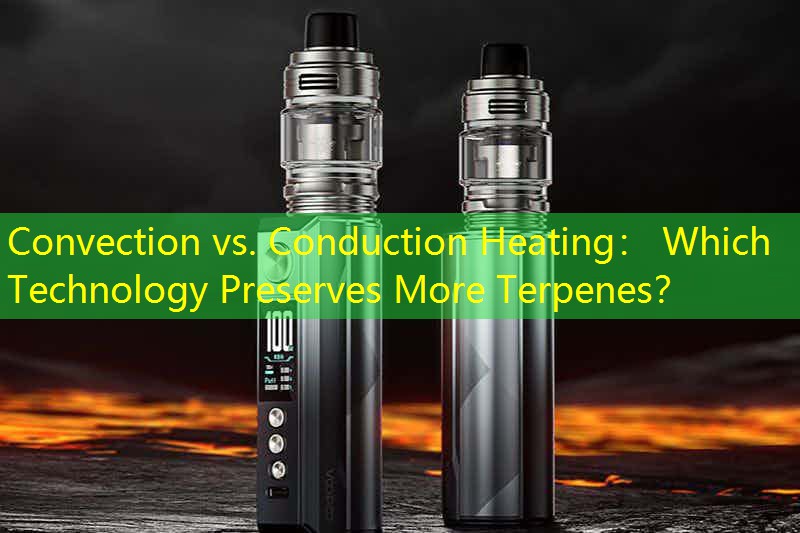Shigowa da
Duniyar Vaporization ya samo asali cikin kwarewa tare da zuwan fasahar dumama daban-daban. Daga cikin wadannan, Dokar da Taron Hankali sun sami hankali sosai, Musamman game da iyawarsu don kiyaye mahaɗan ƙwandanan dandano da aka sani da aka sani da Serpenes. Wannan labarin zai samar da zurfin zurfin a cikin taron vs. Hankalin dumama Fasaha, kimanta halayensu, kwarewar mai amfani, kwatancen gasa, ribobi da cons, da kuma zango.
Humama Fasaha aka bayyana
Hade dumama
Convenction Hajewa yana amfani da iska mai zafi don yin zafi kayan ganye a kaikai, Bada izinin ko da ingancin yanayin zafin jiki daidai. Wannan hanyar tabbatar da cewa m mahadi, gami da terpenes, an tursasa su a mafi kyawun yanayin zafi ba tare da tsintsin kayan. Masu amfani suna godiya da haɗuwa don tsabtace ta da tsabta da kuma dandano, wanda zai iya kiyaye bayanan martaba na musamman na madaukai daban-daban.
Hankali
Da bambanci, Haɗin kai ya dogara da lamba kai tsaye tsakanin kayan dumama da kayan aikin. Yayinda wannan hanyar yawanci sau da yawa kuma zai iya samar da kwarewar tururi, Yana haɗarin overheating, yuwuwar lalata terpanes da sauran mahadi na volatile. Masu amfani gaba ɗaya suna neman na'urorin hana su zama mafi ƙarancin tsada, Amma suna iya ba da amincin dandano don sauri.

Sifofin samfur
Dukkan taron da aka gabatar dasu da kuma hana masu tilastawa sun zo da kewayon fasali, gami da ikon zazzabi, tara, da rayuwar baturi. Na'urorin haɗawa gabaɗaya mafi yawan fasaha na haɓaka wanda yake sauƙaƙe daidaitattun yanayin zafi. Da bambanci, Model na haɗawa na iya bayar da sauƙaƙewa, Yin su da amfani mai amfani da masu amfani da masu amfani.
Kwarewar mai amfani
Kwarewar mai amfani ya bambanta da muhimmanci tsakanin fasahar biyu. Conventing dumama sau da yawa yana buƙatar kwana mai koyo don Master cikakkiyar zane da saitunan yanayin zafi. Duk da haka, Masu amfani da rahoton cewa biya shine wadatar, more nuden dandano. Taɓo, Masu amfani suna godiya da sauƙin amfani amma zai iya lura da bayanan martaba saboda dumama mara kyau.
Kwatancen gasa
A cikin falle, brands kamar wutar lantarki da gobara mai fashewa da ke cikin dumama, Yayinda Pax da G Peh Freel Excel a cikin zaɓuɓɓukan. Na'urar tattara na'urori galibi suna zuwa a mafi girman farashin farashi, yin tunani da manyan iyawarsu. Tukuna, Vavorizers acorizers sau da yawa suna roƙon don masu sayen kasafin kuɗi masu siyar da sauƙin sauƙaƙawa da dacewa.
Ribobi da cons
Convenction dumama ribobi
– Adadin Terpene
– Ko da dumama
– Zuriyar dandano mai girma
Conventing dumama Cons
– Mafi girma farashi
– Mafi rikitarwa don amfani
Ragewa na Haji
– Lokacin zafi mai sauri
– Mai amfani-mai amfani
– Gabaɗaya ƙasa da tsada
Hadawa na Cons
– Yuwuwar rashin daidaituwa
– Hadarin dandano mai ɗanɗano
Binciken mai amfani
Talkantar da Tempitics don Haɗin Kawancen dabbobi yawanci sun hada da Connoisseurs da masu amfani da su wadanda suka fifita dandano da inganci. Mutane waɗannan mutane galibi suna shirye su saka hannun jari sosai a cikin samfurin ƙimar. Da bambanci, na'urorin hana su jawo hankalin wasu masu amfani da kullun ko waɗancan sababbi ga vaping, Kamar yadda suke bayar da wurin shigar da wuri mai sauƙi ba tare da buƙatar ilimi mai zurfi game da sarrafa zafin jiki ko dabarun vaporivation.

Ƙarshe
a takaice, Zabi tsakanin taro da kuma yin dumama da yawa ya dogara da zaɓin mutum da kuma abubuwan da suka faru. Gwajin yana samar da mafi kyawun gogewa ga waɗanda suke neman adana terpees da more rayuwa masu ɗanɗano masu ɗanɗano, yayin da aka dakatar da sauki da sauri don masu amfani da kai. Fahimtar waɗannan bambance-bambance suna da mahimmanci don yin yanke shawara a cikin duniyar mai tsauri na gashin tsuntsaye.







